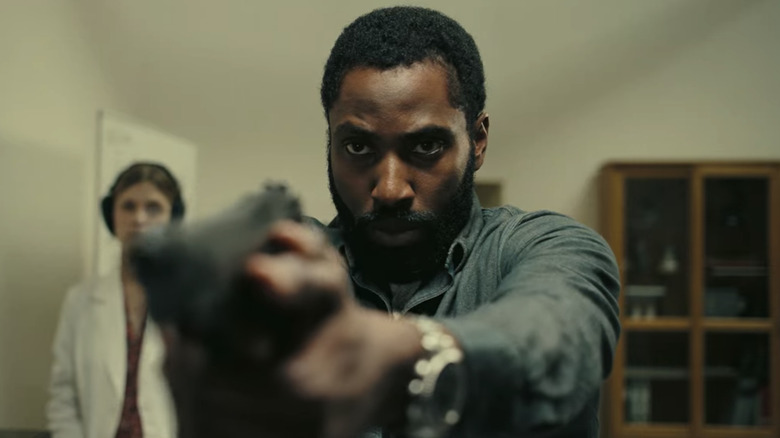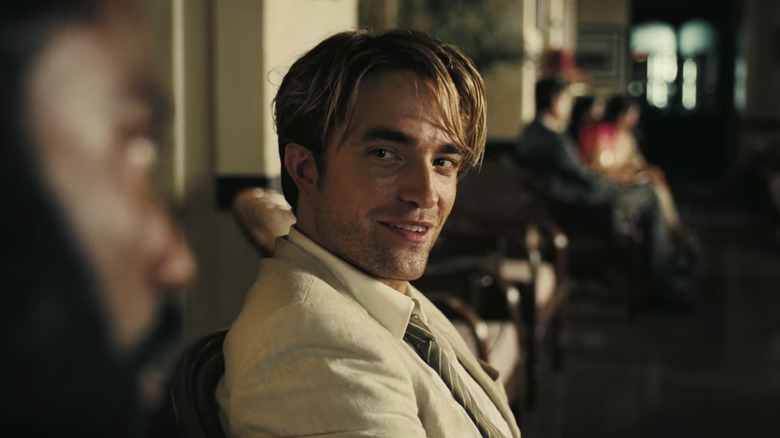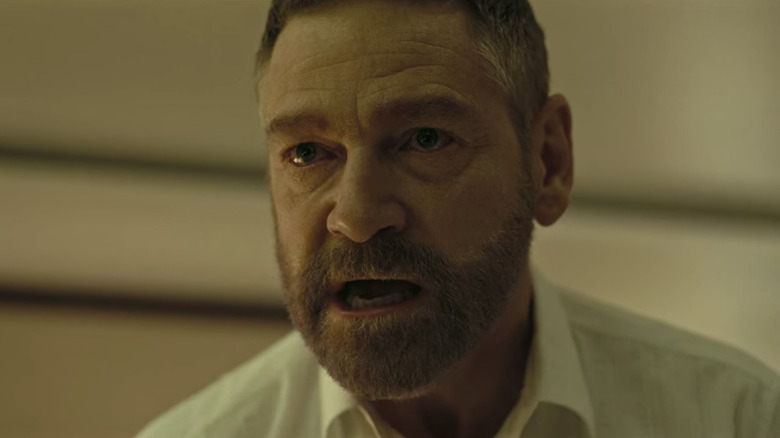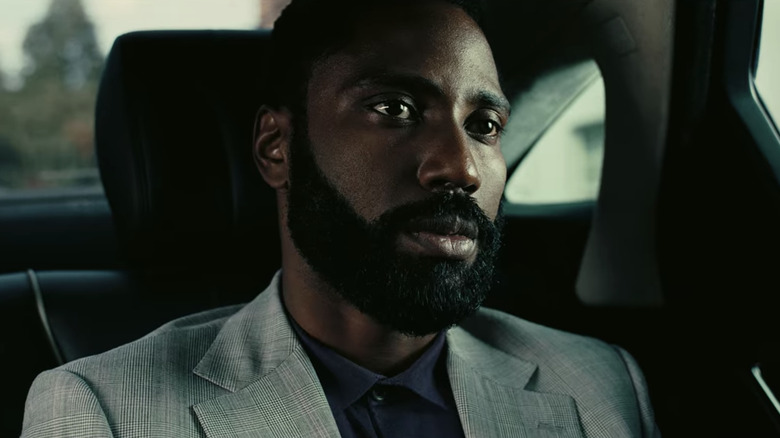Tenet Ending Explained: You're Not Catching The Explanation, You're Shooting It
"Don't try to understand it. Feel it." Hearing that line in Christopher Nolan's "Tenet" may be enough for some viewers, those who were "feeling it," to go with the flow and the reverse chronological current of the movie's convoluted plot, which describes itself as a "temporal pincer movement."
Plot with a capital "P" and sheer blockbuster spectacle do take precedence here over characters, with most of the players in "Tenet" being underdeveloped at best and mere cyphers at worst. Yet for all that, there are certain emotional beats between them, and if you're hooked into those, then maybe you can understand the basics of "Tenet" without needing to draw up diagrams and get bogged down in the nitty-gritty details.
Of course, if you're here, then chances are just as good that you have some lingering questions about the ending of "Tenet." Up until its midway point, Nolan's film is relatively straightforward. Then, we enter a room split by a "proving window," one side of it bathed in red, the other blue, with characters talking forward and backward at the same time. It's pretty trippy.
Some viewers might be hopelessly confused after that (or even before that). Who are those people in gas masks fighting, you might ask? Why are they fighting? For that matter, why does the nameless Protagonist (John David Washington) fight himself?
Well, the good guys are fighting to save the world, naturally. And the reason the Protagonist fights himself is because the present him doesn't know who he's fighting, while the time-inverted future him is just trying to get to the Turnstile machine so he can go back even further in time.
Confused already? Maybe it's best if we just hit the Turnstile now and dive back into "Tenet" and its ending (with spoilers, of course).
Bungee-Jumpable Caverns of Exposition
Does "Tenet" have plot holes? If so, are they "bungee-jumpable?" You'd have to ask Robert Pattinson. His character, Neil, is the one using that word, and like the Protagonist, we're not even convinced it's a real word. However, Neil is rather well-informed about certain things, such as the fact that the Protagonist doesn't drink on the job, which is why he knows to order a Diet Coke for him right after they first meet. This foreknowledge on Neil's part comes up again later.
While "Tenet" does adhere to the masked-and-muffled conceit of other Nolan films in the 2010s, it also makes moves via intellectual dialogue to explain its time inversion principles to the viewer. The real bungee-jumping, as it were, comes in caverns of exposition. There's more than one sequence of the Protagonist and Neil walking and talking, then holding strap handles on public transportation and expositing some more.
Some of the info dumps are humorless, like when a lab technician, played by Clémence Poésy, debriefs the Protagonist on catching a bullet versus shooting it and tells him that the inverted objects they're recovering are "the detritus of a coming war." Yet amid its dense dialogue, backward fights and car chases, and mind-bending causal loops, the movie keeps up a drip-feed of clarity so that we can understand the stakes of the Protagonist's mission.
He's "trying to prevent World War III," as it's ominously put. Meanwhile, the resident Bond villain, Sator (Kenneth Branagh), is gathering the nine artifacts needed to piece together the Algorithm, which will allow him to "invert the entropy of the world." If Sator succeeds, "everyone and everything that's ever lived will be destroyed instantly."
"Including my son?" asks Sator's disaffected wife, Kat (Elizabeth Debicki).
Yes, ma'am, including your son.
If He Can't Have It, No One Can
Sator is basically a solipsist, egocentric to the point of genocide. We learn that he's been in contact with the people of the future, who, like the ones in "Interstellar," are spoken of but never seen — and exist to fill the same dubious movie-god function.
These unseen people and players in the palindromic game of "Tenet" don't believe in the grandfather paradox, whereby a time traveler could hypothetically prevent their own birth by killing their own grandfather. On the other hand, they do appear to believe that if they destroy the past, they can prevent the devastating effects of climate change on the future. One future person is a scientist (another unnamed character) who the movie likens to J. Robert Oppenheimer, the father of the atomic bomb and, coincidentally enough, the subject of Nolan's upcoming movie, "Oppenheimer," starring Cillian Murphy. This scientist, we're told, invented the Algorithm but then killed herself.
Sator plans to do the same thing because he's already dying of cancer. In one scene, while threatening Kat, he draws out the syllables in that Russian accent of his, enunciating the world's worst Sweethearts candy message: "If I can't have you, no one else can." This applies to Kat but also to the world, which will be obliterated the instant Sator dies since he's outfitted himself with a dead man's switch. It's connected to the Algorithm via the fitness tracker he wears on his wrist.
The Protagonist's first attempt at inverting himself to retrieve one of the artifacts ends with him upside-down in a car, experiencing the reverse effect of hypothermia as the vehicle goes up in flames. Since Sator now has all nine components of the Algorithm, the Protagonist, Neil, and Ives (Aaron Taylor-Johnson) devise a new plan to invert themselves a full ten days.
Where Ten Meets neT
It's no coincidence the title of "Tenet" reads like the word "ten" smooshed together in two different directions. Early in the movie, Kat recounts her memory of seeing an unknown woman dive off her husband's yacht. It turns out this was a future version of herself, who came back in time to stall Sator and keep him from killing himself. This raises one potential plot hole, because "Tenet" establishes the need for inverted characters to wear oxygen masks, since "regular air won't pass through the membrane of inverted lungs."
The Kat who stalls Sator — before jumping the gun and killing him herself — isn't wearing a mask, which is why she's able to pass for her past self. However, the Protagonist mentions that Kat is going back an extra day to give her some time to get back to the yacht in Vietnam. Presumably, she went through the Turnstile to the past, then went back through it once more but stayed in the past so that she was moving forward again through it.
While Kat is there on the yacht, the Protagonist, Neil, and Ives lead an assault on Sator's abandoned hometown in Russia. This is where the temporal pincer movement comes into play, with two color-coded teams, the forward-moving red team and the backward-moving blue team, converging on the town. Amid the cacophony of the battlefield, bazooka-ed buildings reassemble themselves just in time to be blown up again, while the Protagonist and Ives form a splinter group and descend an underground tunnel to fetch the Algorithm.
At the end of the tunnel, they encounter Sator's henchman and a masked body with a red string hanging out of its pocket. The string, as Looper observes, is perhaps an allusion to the Chinese Red Thread of Fate, which binds people who are destined to meet.
We soon learn that the body in the tunnel's lockout cage belongs to Neil, who has performed (and will perform) his own one-man temporal pincer movement within the larger one on the battlefield. There are multiple versions of Neil running around, and he was also the mysterious masked ally who saved the Protagonist in the opera house at the beginning of the movie.
An Expression of Faith in the Mechanics
As Neil explains, it was actually the Protagonist who recruited him. "You have a future in the past," he says. Neil's future/past sacrifice in the cage, coupled with the present lifeline he provides from a vehicle outside the tunnel, enables the Protagonist and Ives to grab the Algorithm and escape before the requisite ticking time bomb (because: Hollywood?) blows them sky-high.
Neil's once and future death harkens back to what he said when we first met him: "Time isn't the problem. Getting out alive is the problem." When his present self and the Protagonist part ways, they do so with an appropriately inverted "Casablanca" quote, as Neil says, "For me, this is the end of a beautiful friendship."
Ives walks off with his third of the disassembled Algorithm and with the understanding that if he ever catches up with Neil and the Protagonist, he'll neutralize them to ensure that no one ever learns the Algorithm's world-endangering secrets. As he leaves, he sums up the film by saying, "This whole operation's a temporal pincer." It's a wink from Nolan the screenwriter, whose name itself is only one letter off from a palindrome.
In a way, "Tenet" is a near-rhyme or slant-rhyme like that. While it may make sense in its own head, not everything in it matches up perfectly with what the audience — those of us out here in the opera house's "cheap seats" — might hope for in a lucid film narrative.
At the very end, the Protagonist, who now knows he's the leader, truly "the protagonist of this operation," responds to a call from Kat, saving her from the arms dealer and rogue Tenet organization member, Priya (Dimple Kapadia). Before taking Priya out, the Protagonist tells her, "We've both been working for me."
True to form for Nolan, "Tenet" follows its own nesting-doll logic, layering pincers within pincers and puzzlement within entertainment the way "Inception" layered dreams within dreams. Neil explains that his catchphrase, "What's happened, happened," is "an expression of faith in the mechanics of the world." Whether or not the viewer has faith in the mechanics of Nolan's plot may depend on how willing they are to just sit back, roll with the freeport jumbo jet crash, and turn off their brain before it gets fried.




